Archive for March, 2010
-
Where is Yellowstone national park located?
Posted in North America | March 24, 2010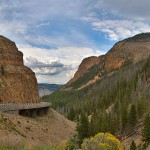 Yellowstone National Park is full of several interesting and unusual geological characteristics that cannot be found everywhere in the world. This gigantic caldera or volcanic crater is the remainder of a massive volcano that erupted many millennia ago. As the area rests on the active volcano, it has many fascinating geothermal phenomena. As this place is not known to many tourists and always. Where is Yellowstone national park located? Beside the borders of Idaho and Montana to the northwestern side of Wyoming is situated Yellowstone National Park. The location of the park is not completely in the middle of nowhere, but one could get confused. From the northeast of Idaho Falls Idaho, the park is 100 miles away; from north of Jackson Wyoming [...]
Yellowstone National Park is full of several interesting and unusual geological characteristics that cannot be found everywhere in the world. This gigantic caldera or volcanic crater is the remainder of a massive volcano that erupted many millennia ago. As the area rests on the active volcano, it has many fascinating geothermal phenomena. As this place is not known to many tourists and always. Where is Yellowstone national park located? Beside the borders of Idaho and Montana to the northwestern side of Wyoming is situated Yellowstone National Park. The location of the park is not completely in the middle of nowhere, but one could get confused. From the northeast of Idaho Falls Idaho, the park is 100 miles away; from north of Jackson Wyoming [...] -
See Grizzly Bears in the Banff National Park
Posted in North America | March 24, 2010 In 1885, the Banff National Park was created in the Rocky Mountains. It is one of the oldest national parks of Canada. It is situated in the province of Alberta to the 110 -180 kilometers to the west of Calgary. The Banff National Park land measure 6,641 square kilometers, which comprises of alpine landscape, several ice fields and glaciers, thick coniferous forest and mountainous terrain. The Ice field Parkway stretches from Lake Louise across to the north of Jasper National Park. The Banff National Park is bounded by other national parks like Yoho National Park and Provincial forests are west to it, whereas to the south is Kootenay National Park and to the southeast is the Kananaskis Country. In the Bow River valley, there is a town named [...]
In 1885, the Banff National Park was created in the Rocky Mountains. It is one of the oldest national parks of Canada. It is situated in the province of Alberta to the 110 -180 kilometers to the west of Calgary. The Banff National Park land measure 6,641 square kilometers, which comprises of alpine landscape, several ice fields and glaciers, thick coniferous forest and mountainous terrain. The Ice field Parkway stretches from Lake Louise across to the north of Jasper National Park. The Banff National Park is bounded by other national parks like Yoho National Park and Provincial forests are west to it, whereas to the south is Kootenay National Park and to the southeast is the Kananaskis Country. In the Bow River valley, there is a town named [...] -
Mt Rainier National Park
Posted in North America | March 23, 2010 Mt Rainier National Park ranks fifth national park of United States. It was created on 2nd March 1899 and measures 368 square miles including Mountains of Rainier. It is situated in Washington State to the northeast Lewis County and southeast of Pierce County. Mt Rainier National Park has outstanding attractions for mountain climbing picturesque drives, and hiking. A good number of roads are accessible from end of May to beginning of October, along with it; it has eye-catching views as well as a variety of hiking tracks and many more sites. Though several visitors plan their visit to the park for a day, mull over a thorough journeying of on one or two areas of the park. The most recommended areas are Paradise, sunrise and Carbon River. Paradise: It [...]
Mt Rainier National Park ranks fifth national park of United States. It was created on 2nd March 1899 and measures 368 square miles including Mountains of Rainier. It is situated in Washington State to the northeast Lewis County and southeast of Pierce County. Mt Rainier National Park has outstanding attractions for mountain climbing picturesque drives, and hiking. A good number of roads are accessible from end of May to beginning of October, along with it; it has eye-catching views as well as a variety of hiking tracks and many more sites. Though several visitors plan their visit to the park for a day, mull over a thorough journeying of on one or two areas of the park. The most recommended areas are Paradise, sunrise and Carbon River. Paradise: It [...] -
Beautiful Bee-Eater – Part – II
Posted in Wildlife A-Z | March 23, 2010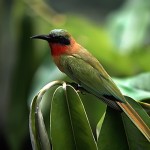 The birds have a wonderful time in Africa. Male bee-eaters have their own flocks. Grass fires attract bee-eaters in large numbers as there are plenty of insects. Spanish male birds mate with Italian female birds. It also common to see birds from Kazakhstan pair up with those from Hungary. It is back to Europe during springtime. Some of these pairs last for a lifetime. Their home usually comprises sandstone cliffs and sandy riverbanks. They hesitate to begin a family in a soiled nest. They excavate their own burrows. They have the ability to peck continuously for 20 days. At the end of the job, they have moved nearly 15 to 25 pounds of soil. This is more than 80 times their body weight. In the process, their beaks get chipped to one sixteenth [...]
The birds have a wonderful time in Africa. Male bee-eaters have their own flocks. Grass fires attract bee-eaters in large numbers as there are plenty of insects. Spanish male birds mate with Italian female birds. It also common to see birds from Kazakhstan pair up with those from Hungary. It is back to Europe during springtime. Some of these pairs last for a lifetime. Their home usually comprises sandstone cliffs and sandy riverbanks. They hesitate to begin a family in a soiled nest. They excavate their own burrows. They have the ability to peck continuously for 20 days. At the end of the job, they have moved nearly 15 to 25 pounds of soil. This is more than 80 times their body weight. In the process, their beaks get chipped to one sixteenth [...] -
Beautiful Bee-Eater – Part – I
Posted in Wildlife A-Z | March 22, 2010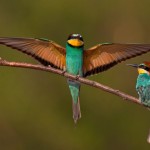 What is it with birds and poems? Keats had his nightingale, while Poe his raven. If I have to compare the life of the bee-eater with a literary work, it would be nothing short of an epic novel. The plot of the novel would be spread across several continents involving intrigue, theft, danger, chicanery, and gorgeous beauty. Can you guess how many colors are present on the body of the bee-eater? I, too, am at a loss for words. The chestnut crown blends beautifully with the black robber’s mask. The breast comprises of a turquoise blue, while the throat resembles the tinge of ripening wheat. I guess this is just what the doctor ordered for a bird that does not like to play it safe. The bee-eaters are true to their name: they eat bees. Besides [...]
What is it with birds and poems? Keats had his nightingale, while Poe his raven. If I have to compare the life of the bee-eater with a literary work, it would be nothing short of an epic novel. The plot of the novel would be spread across several continents involving intrigue, theft, danger, chicanery, and gorgeous beauty. Can you guess how many colors are present on the body of the bee-eater? I, too, am at a loss for words. The chestnut crown blends beautifully with the black robber’s mask. The breast comprises of a turquoise blue, while the throat resembles the tinge of ripening wheat. I guess this is just what the doctor ordered for a bird that does not like to play it safe. The bee-eaters are true to their name: they eat bees. Besides [...] -
Amazing Flight of the Albatross – Part – IV
Posted in Wildlife A-Z | March 22, 2010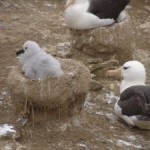 As I reached the north cliffs, the skies were covered with dense clouds. I was touched by the thousands of birds gliding through the shafts of the sun. They glided between the low heavens and pewter sea. Their braying and cooing lingers in the air. The scent of guano, too, is strong. The nests contain month-old chicks that sit like snowmen. As the adults arrive to feed them, I am spellbound. The adult albatross converts food into high-density oil that matches the calorific content of diesel. The parent and the chick greet each other with crossed bills. Following this, the adult squirts oil resembling the filling of a tank. Adults spend nearly 15 minutes feeding its chick. The chicks consume food three times its body weight. The adults then travel [...]
As I reached the north cliffs, the skies were covered with dense clouds. I was touched by the thousands of birds gliding through the shafts of the sun. They glided between the low heavens and pewter sea. Their braying and cooing lingers in the air. The scent of guano, too, is strong. The nests contain month-old chicks that sit like snowmen. As the adults arrive to feed them, I am spellbound. The adult albatross converts food into high-density oil that matches the calorific content of diesel. The parent and the chick greet each other with crossed bills. Following this, the adult squirts oil resembling the filling of a tank. Adults spend nearly 15 minutes feeding its chick. The chicks consume food three times its body weight. The adults then travel [...] -
Amazing Flight of the Albatross – Part – III
Posted in Wildlife A-Z | March 19, 2010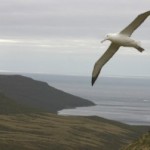 Campbell Island is the nesting place of the southern royal albatross. It lies 400 miles south of New Zealand. The island has fantastic waves and birds. The birds include giant petrels, shearwaters, and our very own albatross. The markings of the pintado petrels give them the appearance of flying dominoes. The tall cliffs obscure the island’s loneliness. There is a constant blowing of chilly winds. The Campbell albatross is unique to the island, with a grey head and light mantle. The brows are jet black in color. There are no vehicles on Campbell Island. The rhythm of the legs determines the time and distance covered. A 45-minute walk is the most direct route at leads to the birds. I have spotted many birds in the broad alley. I seem to misjudge [...]
Campbell Island is the nesting place of the southern royal albatross. It lies 400 miles south of New Zealand. The island has fantastic waves and birds. The birds include giant petrels, shearwaters, and our very own albatross. The markings of the pintado petrels give them the appearance of flying dominoes. The tall cliffs obscure the island’s loneliness. There is a constant blowing of chilly winds. The Campbell albatross is unique to the island, with a grey head and light mantle. The brows are jet black in color. There are no vehicles on Campbell Island. The rhythm of the legs determines the time and distance covered. A 45-minute walk is the most direct route at leads to the birds. I have spotted many birds in the broad alley. I seem to misjudge [...] -
Amazing Flight of the Albatross – Part – II
Posted in Wildlife A-Z | March 19, 2010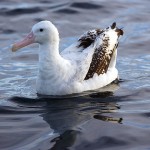 Albatrosses thrive in areas that cannot be imagined. Elemental islands are the primary areas. However, there exists no place untouched by humans. As a result, the population has been dwindling steadily. To make sure I got the best view, I chose the most populous albatross colony on the planet. The species are under threat of extinction. To increase their numbers, we need to sign a deal with them. Failing which, we may never again lay sight on so beautiful a species. Falklands’ Steeple Jason Island is graceful with tussock grass growing to head height. As I walked around the island, I witnessed a living miracle: a group of black-browed albatrosses crowding the ledges and shoreline. The heads of the birds are decorated with black stripes, just [...]
Albatrosses thrive in areas that cannot be imagined. Elemental islands are the primary areas. However, there exists no place untouched by humans. As a result, the population has been dwindling steadily. To make sure I got the best view, I chose the most populous albatross colony on the planet. The species are under threat of extinction. To increase their numbers, we need to sign a deal with them. Failing which, we may never again lay sight on so beautiful a species. Falklands’ Steeple Jason Island is graceful with tussock grass growing to head height. As I walked around the island, I witnessed a living miracle: a group of black-browed albatrosses crowding the ledges and shoreline. The heads of the birds are decorated with black stripes, just [...] -
Amazing Flight of the Albatross – Part – I
Posted in Wildlife A-Z | March 18, 2010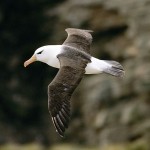 What comes to your mind when you think of a flying machine? Can it be the albatross which is designed to be one of the best flying species on the planet? The albatross is made up bone, feathers, muscle and wind, which give the bird its flying prowess. Watching the bird in full flight gives the impression as if it were propelled into the sky. The albatross is more of an art deco bird, which has striking patterns. It is known for its faithfulness and epic travels. Parent albatrosses are known to fly for more than 10,000 miles to feed their chicks. They have the longest wings in the world, stretching up to 3.5 meters. These beauties can glide for hundreds of miles without flapping their wings. Besides crossing ocean basins, they have circumnavigated [...]
What comes to your mind when you think of a flying machine? Can it be the albatross which is designed to be one of the best flying species on the planet? The albatross is made up bone, feathers, muscle and wind, which give the bird its flying prowess. Watching the bird in full flight gives the impression as if it were propelled into the sky. The albatross is more of an art deco bird, which has striking patterns. It is known for its faithfulness and epic travels. Parent albatrosses are known to fly for more than 10,000 miles to feed their chicks. They have the longest wings in the world, stretching up to 3.5 meters. These beauties can glide for hundreds of miles without flapping their wings. Besides crossing ocean basins, they have circumnavigated [...] -
Wonderful Wolves of Ethiopia
Posted in Africa | March 18, 2010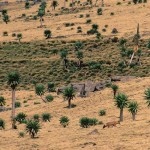 Picture this. Sanetti Plateau among the Bale Mountains of Ethiopia. The mornings could not have been more chilled. The first rays of the sun stir an icy, cold wind instead of warmth. As I tug at my gaiter and move through the frozen grass, I have to remind myself that I am in Africa. Out of nowhere, a wolf appears mere 20 feet away. Daintily, she throws back her head and within seconds a loud cry is uttered that summons four others of the pack. This time, all males. They greet each other by licking the fellow muzzles. Pawing and stretching never seems to stop. Tails continue to wag. It is hard to withdraw the eyes from such a wonderful spectacle. Can you imagine how many colors are adorned on their beautiful bodies? The black and white tails [...]
Picture this. Sanetti Plateau among the Bale Mountains of Ethiopia. The mornings could not have been more chilled. The first rays of the sun stir an icy, cold wind instead of warmth. As I tug at my gaiter and move through the frozen grass, I have to remind myself that I am in Africa. Out of nowhere, a wolf appears mere 20 feet away. Daintily, she throws back her head and within seconds a loud cry is uttered that summons four others of the pack. This time, all males. They greet each other by licking the fellow muzzles. Pawing and stretching never seems to stop. Tails continue to wag. It is hard to withdraw the eyes from such a wonderful spectacle. Can you imagine how many colors are adorned on their beautiful bodies? The black and white tails [...]


